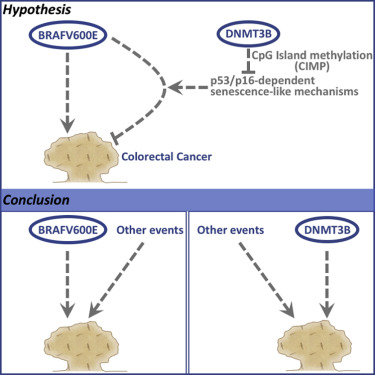iScience ( IF 5.8 ) Pub Date : 2020-01-14 , DOI: 10.1016/j.isci.2020.100838 Douglas J MacKenzie 1 , Neil A Robertson 1 , Iqbal Rather 1 , Claire Reid 1 , Gintare Sendzikaite 1 , Hazel Cruickshanks 1 , Tony McBryan 1 , Andrew Hodges 2 , Catrin Pritchard 3 , Karen Blyth 4 , Peter D Adams 5

|
Approximately 10% of human colorectal cancer (CRC) are associated with activated BRAFV600E mutation, typically in absence of APC mutation and often associated with a CpG island methylator (CIMP) phenotype. To protect from cancer, normal intestinal epithelial cells respond to oncogenic BRAFV600E by activation of intrinsic p53 and p16-dependent tumor suppressor mechanisms, such as cellular senescence. Conversely, CIMP is thought to contribute to bypass of these tumor suppressor mechanisms, e.g. via epigenetic silencing of tumor suppressor genes, such as p16. It has been repeatedly proposed that DNMT3B is responsible for BRAFV600E-induced CIMP in human CRC. Here we set out to test this by in silico, in vitro, and in vivo approaches. We conclude that although both BRAFV600E and DNMT3B harbor oncogenic potential in vitro and in vivo and show some evidence of cooperation in tumor promotion, they do not frequently cooperate to promote CIMP and human intestinal cancer.
中文翻译:

DNMT3B在人肠癌中的致癌活性与CIMP或BRAFV600E突变无关。
大约10%的人类大肠癌(CRC)与激活的BRAFV600E突变相关,通常不存在APC突变,并且通常与CpG岛甲基化(CIMP)表型相关。为了预防癌症,正常肠上皮细胞会通过激活内在的p53和p16依赖性肿瘤抑制机制(例如细胞衰老)来响应致癌性BRAFV600E。相反地,CIMP被认为例如通过诸如p16之类的肿瘤抑制基因的表观遗传沉默而有助于绕过这些肿瘤抑制机制。反复提出DNMT3B负责BRAFV600E诱导的人CRC中的CIMP。在这里,我们开始通过计算机模拟,体外和体内测试方法。我们得出的结论是,尽管BRAFV600E和DNMT3B在体外和体内都具有致癌潜力,并显示出在肿瘤促进方面有合作的证据,但它们并不经常合作促进CIMP和人类肠道癌。


























 京公网安备 11010802027423号
京公网安备 11010802027423号